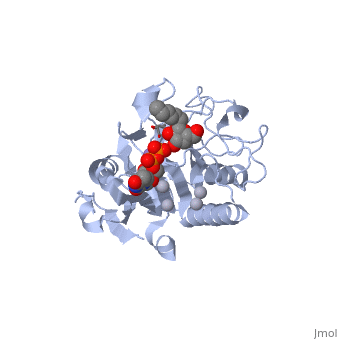1lzj
From Proteopedia
(New page: 200px<br /> <applet load="1lzj" size="450" color="white" frame="true" align="right" spinBox="true" caption="1lzj, resolution 1.32Å" /> '''Glycosyltransferase...) |
|||
| Line 1: | Line 1: | ||
| - | [[Image:1lzj.gif|left|200px]]<br /> | + | [[Image:1lzj.gif|left|200px]]<br /><applet load="1lzj" size="350" color="white" frame="true" align="right" spinBox="true" |
| - | <applet load="1lzj" size=" | + | |
caption="1lzj, resolution 1.32Å" /> | caption="1lzj, resolution 1.32Å" /> | ||
'''Glycosyltransferase B + UDP + H antigen acceptor'''<br /> | '''Glycosyltransferase B + UDP + H antigen acceptor'''<br /> | ||
==Overview== | ==Overview== | ||
| - | The human ABO(H) blood group antigens are produced by specific | + | The human ABO(H) blood group antigens are produced by specific glycosyltransferase enzymes. An N-acetylgalactosaminyltransferase (GTA) uses a UDP-GalNAc donor to convert the H-antigen acceptor to the A antigen, whereas a galactosyltransferase (GTB) uses a UDP-galactose donor to convert the H-antigen acceptor to the B antigen. GTA and GTB differ only in the identity of four critical amino acid residues. Crystal structures at 1.8-1.32 A resolution of the GTA and GTB enzymes both free and in complex with disaccharide H-antigen acceptor and UDP reveal the basis for donor and acceptor specificity and show that only two of the critical amino acid residues are positioned to contact donor or acceptor substrates. Given the need for stringent stereo- and regioselectivity in this biosynthesis, these structures further demonstrate that the ability of the two enzymes to distinguish between the A and B donors is largely determined by a single amino acid residue. |
==Disease== | ==Disease== | ||
| Line 11: | Line 10: | ||
==About this Structure== | ==About this Structure== | ||
| - | 1LZJ is a [http://en.wikipedia.org/wiki/Single_protein Single protein] structure of sequence from [http://en.wikipedia.org/wiki/Homo_sapiens Homo sapiens] with HG, MN and UDP as [http://en.wikipedia.org/wiki/ligands ligands]. Full crystallographic information is available from [http:// | + | 1LZJ is a [http://en.wikipedia.org/wiki/Single_protein Single protein] structure of sequence from [http://en.wikipedia.org/wiki/Homo_sapiens Homo sapiens] with <scene name='pdbligand=HG:'>HG</scene>, <scene name='pdbligand=MN:'>MN</scene> and <scene name='pdbligand=UDP:'>UDP</scene> as [http://en.wikipedia.org/wiki/ligands ligands]. Full crystallographic information is available from [http://oca.weizmann.ac.il/oca-bin/ocashort?id=1LZJ OCA]. |
==Reference== | ==Reference== | ||
| Line 17: | Line 16: | ||
[[Category: Homo sapiens]] | [[Category: Homo sapiens]] | ||
[[Category: Single protein]] | [[Category: Single protein]] | ||
| - | [[Category: Borisova, S | + | [[Category: Borisova, S N.]] |
| - | [[Category: Evans, S | + | [[Category: Evans, S V.]] |
| - | [[Category: Marcus, S | + | [[Category: Marcus, S L.]] |
| - | [[Category: Palcic, M | + | [[Category: Palcic, M M.]] |
| - | [[Category: Patenaude, S | + | [[Category: Patenaude, S I.]] |
| - | [[Category: Seto, N | + | [[Category: Seto, N O.L.]] |
[[Category: Szpacenko, A.]] | [[Category: Szpacenko, A.]] | ||
[[Category: HG]] | [[Category: HG]] | ||
| Line 32: | Line 31: | ||
[[Category: transmembrane]] | [[Category: transmembrane]] | ||
| - | ''Page seeded by [http:// | + | ''Page seeded by [http://oca.weizmann.ac.il/oca OCA ] on Thu Feb 21 13:49:55 2008'' |
Revision as of 11:50, 21 February 2008
|
Glycosyltransferase B + UDP + H antigen acceptor
Contents |
Overview
The human ABO(H) blood group antigens are produced by specific glycosyltransferase enzymes. An N-acetylgalactosaminyltransferase (GTA) uses a UDP-GalNAc donor to convert the H-antigen acceptor to the A antigen, whereas a galactosyltransferase (GTB) uses a UDP-galactose donor to convert the H-antigen acceptor to the B antigen. GTA and GTB differ only in the identity of four critical amino acid residues. Crystal structures at 1.8-1.32 A resolution of the GTA and GTB enzymes both free and in complex with disaccharide H-antigen acceptor and UDP reveal the basis for donor and acceptor specificity and show that only two of the critical amino acid residues are positioned to contact donor or acceptor substrates. Given the need for stringent stereo- and regioselectivity in this biosynthesis, these structures further demonstrate that the ability of the two enzymes to distinguish between the A and B donors is largely determined by a single amino acid residue.
Disease
Known disease associated with this structure: Blood group, ABO system OMIM:[110300]
About this Structure
1LZJ is a Single protein structure of sequence from Homo sapiens with , and as ligands. Full crystallographic information is available from OCA.
Reference
The structural basis for specificity in human ABO(H) blood group biosynthesis., Patenaude SI, Seto NO, Borisova SN, Szpacenko A, Marcus SL, Palcic MM, Evans SV, Nat Struct Biol. 2002 Sep;9(9):685-90. PMID:12198488
Page seeded by OCA on Thu Feb 21 13:49:55 2008

